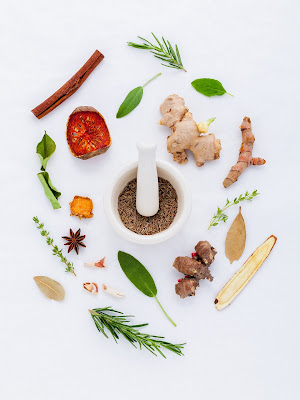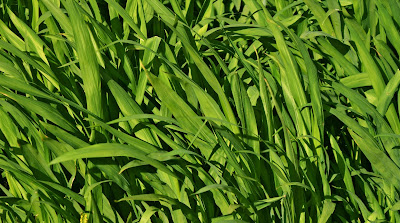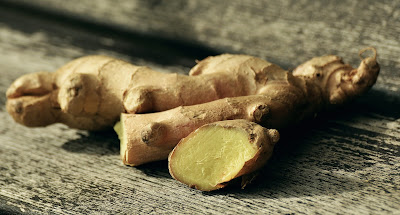Here are 20 herbs that are known for their anti-inflammatory properties:
Turmeric: Contains curcumin, a powerful anti-inflammatory compound.
Ginger: Has potent anti-inflammatory and antioxidant effects.
Garlic: Contains sulfur compounds that have anti-inflammatory properties.
Cinnamon: Helps reduce inflammation and stabilize blood sugar levels.
Rosemary: Contains rosmarinic acid, which has anti-inflammatory properties.
Basil: Contains essential oils that possess anti-inflammatory effects.
Oregano: Rich in antioxidants and compounds that have anti-inflammatory benefits.
Thyme: Contains thymol, a compound with anti-inflammatory properties.
Sage: Has anti-inflammatory and antioxidant effects.
Clove: Contains eugenol, a compound known for its anti-inflammatory properties.
Cayenne pepper: Contains capsaicin, which has anti-inflammatory effects.
Green tea: Rich in polyphenols, including epigallocatechin gallate (EGCG), which has anti-inflammatory properties.
Chamomile: Contains chamazulene and other compounds with anti-inflammatory benefits.
Licorice root: Has anti-inflammatory and immune-modulating properties.
Echinacea: Known for its immune-enhancing and anti-inflammatory effects.
Cat's claw: Contains compounds that inhibit inflammation.
Boswellia: Also known as frankincense, it has potent anti-inflammatory properties.
Ginkgo biloba: Has antioxidant and anti-inflammatory effects.
Holy basil: Contains eugenol, rosmarinic acid, and other compounds with anti-inflammatory benefits.
Devil's claw: Traditionally used for its anti-inflammatory properties.
It's worth noting that while these herbs have shown promise in combating inflammation, individual responses may vary. Additionally, it's always a good idea to consult with a healthcare professional or a qualified herbalist before incorporating herbs into your routine, especially if you have any existing health conditions or are taking medications.
Fitness Weight Loss Exercises - All You Need To Know On Weight Loss, Fat Loss, Belly Fat Loss, Diets To Lose Weight, Diets and Foods To Lose Belly Fat, Painless Workouts, Abs, Fitness, and Health.
Tuesday, May 16, 2023
Top 20 Herbs That Counter Inflammation
Tuesday, May 2, 2023
Health And Weight Loss Benefits Of Barnyard Millet
Barnyard millet is a cereal grain that is widely consumed in India and other parts of Asia. It is a nutritious food that offers several health and weight loss benefits, including:
High in fiber: Barnyard millet is high in fiber, which can help improve digestion, reduce the risk of constipation, and promote satiety. Consuming high-fiber foods can also help regulate blood sugar levels, lower cholesterol levels, and reduce the risk of heart disease.
Low glycemic index: Barnyard millet has a low glycemic index, which means that it releases glucose into the bloodstream slowly. This can help regulate blood sugar levels, reduce cravings for sugary or high-carbohydrate foods, and promote weight loss.
Low in calories: Barnyard millet is low in calories, making it an ideal food for weight loss. Consuming low-calorie foods can help create a calorie deficit, which is necessary for weight loss.
Gluten-free: Barnyard millet is gluten-free, making it an excellent food choice for people with celiac disease or gluten intolerance.
Rich in vitamins and minerals: Barnyard millet is a good source of several vitamins and minerals, including iron, magnesium, phosphorus, and vitamin B6. These nutrients are essential for maintaining good health and can help boost energy levels and reduce the risk of chronic diseases.
Versatile: Barnyard millet is a versatile food that can be used in a variety of recipes, including porridge, bread, salads, and soups. This makes it easy to incorporate into a healthy diet.
Barnyard millet is a nutritious and versatile food that offers several health and weight loss benefits. It is high in fiber, low in calories, and has a low glycemic index, making it an excellent food choice for people looking to lose weight or maintain a healthy diet. It is also a good source of vitamins and minerals, making it an ideal food for overall health and well-being.
Monday, April 24, 2023
Is Fresh Or Dried Ginger Better For Weight Loss
Ginger is a root that is commonly used in Asian, Middle Eastern, and Caribbean cuisines. It has a spicy, pungent flavor and is known for its many potential health benefits. Here are some of the potential health benefits of ginger:
Anti-inflammatory properties: Ginger contains compounds called gingerols and shogaols, which have potent anti-inflammatory properties. This makes it a useful supplement for those with inflammatory conditions such as arthritis.
Nausea relief: Ginger has been traditionally used to relieve nausea and vomiting, particularly in those undergoing chemotherapy or surgery.
Improved digestion: Ginger can help improve digestion by increasing the activity of digestive enzymes, reducing bloating and gas, and improving bowel movements.
Lowered blood sugar: Some studies have found that ginger can help lower blood sugar levels, making it a useful supplement for those with diabetes.
Pain relief: Ginger has been shown to help relieve pain, particularly in those with menstrual cramps and osteoarthritis.
Potential weight loss benefits: Some studies have found that ginger may help promote weight loss by reducing appetite, increasing feelings of fullness, and reducing calorie intake.
Both dried and fresh ginger have health benefits, but fresh ginger may be more potent due to its higher content of gingerols and shogaols. However, dried ginger can be more convenient to use and has a longer shelf life. Ultimately, the best choice may depend on personal preference and the intended use of the ginger.
Saturday, April 15, 2023
Super Charge Your Weight Loss Goals With Quinoa
Quinoa (pronounced KEEN-wah) is a grain crop that is grown for its edible seeds. It is a nutrient-rich food that has become increasingly popular in recent years due to its numerous health benefits. Here are some of the benefits of quinoa:
High in nutrients: Quinoa is a good source of protein, fiber, vitamins, and minerals, including iron, magnesium, phosphorus, and potassium.
Gluten-free: Quinoa is naturally gluten-free, making it a great alternative to wheat and other grains for people with gluten intolerance.
Low glycemic index: Quinoa has a low glycemic index, which means it doesn't cause a rapid spike in blood sugar levels, making it a good option for people with diabetes.
Weight loss: Quinoa is a low-calorie food and contains protein and fiber, both of which help to keep you feeling full for longer periods, which can help with weight loss.
Heart health: Quinoa is a good source of heart-healthy fats and antioxidants, which can help to reduce inflammation and lower the risk of heart disease.
Digestive health: Quinoa is a good source of fiber, which helps to keep your digestive system healthy and prevent constipation.
To specifically answer your question about how quinoa can help with weight loss, here's how:
Quinoa is low in calories but high in protein and fiber, both of which can help you feel full for longer periods. This can help you eat fewer calories overall, which is important for weight loss. Additionally, quinoa is a complex carbohydrate, meaning it is digested slowly, which can help to regulate blood sugar levels and prevent overeating. Lastly, quinoa is a versatile ingredient that can be used in many different dishes, making it easy to incorporate into a healthy diet.
Saturday, April 8, 2023
Can You Lose Excess Body Weight Without Exercise
Yes, it is possible to lose excess weight without exercise. The key to losing weight is to create a calorie deficit, which means burning more calories than you consume. This can be achieved through dietary changes alone, without exercise.
Here are some dietary changes that can help you lose weight:
Eat a calorie-controlled diet: This means consuming fewer calories than your body needs to maintain your current weight. You can achieve this by reducing your portion sizes, choosing lower calorie foods, and avoiding high-calorie foods and drinks.
Focus on whole, nutrient-dense foods: Foods that are high in fiber, protein, and healthy fats can help you feel fuller for longer and reduce your overall calorie intake. Examples include fruits, vegetables, lean proteins, and whole grains.
Avoid processed foods and added sugars: Processed foods and added sugars are often high in calories and low in nutrients. Avoiding these types of foods can help you reduce your calorie intake and improve your overall health.
Stay hydrated: Drinking plenty of water can help you feel fuller and reduce your overall calorie intake. It can also help improve your digestion and metabolism.
Get enough sleep: Lack of sleep can disrupt your hormones, including those that regulate hunger and fullness. Getting enough sleep can help you make better food choices and reduce your overall calorie intake.
Remember, losing weight without exercise may take longer than if you combine dietary changes with physical activity. However, it is still possible to achieve significant weight loss by making sustainable changes to your diet and lifestyle.
You may find this useful in your weight loss journey. Click here to access.
Thursday, March 30, 2023
All You Want To Know About The Low-FODMAP Diet
The low-FODMAP diet is a therapeutic approach used to manage digestive disorders such as Irritable Bowel Syndrome (IBS), Crohn's disease, and Ulcerative Colitis. FODMAP stands for Fermentable Oligosaccharides, Disaccharides, Monosaccharides, and Polyols, which are short-chain carbohydrates and sugar alcohols found in many foods. These compounds are poorly absorbed by the small intestine, leading to increased water content and gas production in the gut, causing symptoms such as bloating, abdominal pain, diarrhea, and constipation. The low-FODMAP diet involves avoiding foods high in these compounds and gradually reintroducing them to identify specific trigger foods for individual patients.
The low-FODMAP diet is usually divided into three stages: elimination, reintroduction, and personalization. The elimination phase is the most restrictive and lasts for two to six weeks. During this phase, patients are advised to avoid high-FODMAP foods such as wheat, onions, garlic, legumes, dairy products, and certain fruits such as apples, pears, and stone fruits. Instead, they are encouraged to eat low-FODMAP foods such as meat, fish, poultry, eggs, lactose-free dairy products, gluten-free grains, and selected fruits and vegetables such as bananas, blueberries, carrots, and spinach.
The reintroduction phase involves systematically reintroducing FODMAP foods one at a time to identify which ones trigger symptoms. This phase usually lasts for several weeks and involves gradually increasing the amount of FODMAPs consumed. Patients keep a symptom diary to monitor any changes and identify specific trigger foods.
The personalization phase is the final stage of the low-FODMAP diet and involves developing a personalized diet plan based on individual tolerances. Patients are advised to include as many low-FODMAP foods as possible to ensure a balanced and varied diet while avoiding or limiting high-FODMAP foods that trigger symptoms. They may also need to take supplements or modify their diet based on their specific needs and medical history.
Research studies have shown that the low-FODMAP diet can be effective in managing IBS symptoms in up to 75% of patients. However, it is important to note that the diet is not a cure for digestive disorders and should only be used under the guidance of a healthcare professional. It is also important to note that the low-FODMAP diet is not recommended for long-term use as it may lead to nutrient deficiencies and changes in gut microbiota.
Furthermore, the low-FODMAP diet can be challenging to follow, as it requires significant dietary changes and meal planning. It is also important to note that not all high-FODMAP foods will trigger symptoms in all patients, and some low-FODMAP foods may cause symptoms in certain individuals. Therefore, it is important to work with a healthcare professional to ensure a proper diagnosis and to develop an individualized plan.
In conclusion, the low-FODMAP diet is a therapeutic approach used to manage digestive disorders such as IBS. The diet involves avoiding high-FODMAP foods during the elimination phase, systematically reintroducing them during the reintroduction phase to identify trigger foods, and developing a personalized plan during the personalization phase. While the low-FODMAP diet can be effective in managing symptoms, it is important to work with a healthcare professional and not use it for long-term use.
Wednesday, March 22, 2023
Top 10 Weight Loss And Belly Fat Burning Foods
Belly fat is a common concern for many people, and can be a risk factor for a variety of health issues, including diabetes and heart disease. Fortunately, there are certain foods that have been shown to promote belly fat loss by increasing metabolism, reducing inflammation, and promoting feelings of fullness.
One way that belly fat burning foods promote weight loss is by increasing metabolism. Certain foods, such as chili peppers and green tea, contain compounds that have been shown to increase metabolism and promote fat burning. This can help to reduce the amount of belly fat that the body stores.
Another way that belly fat burning foods promote weight loss is by reducing inflammation. Chronic inflammation can contribute to the development of belly fat, and certain foods, such as berries and leafy greens, contain antioxidants that can help to reduce inflammation and promote fat loss.
Finally, belly fat burning foods can promote weight loss by promoting feelings of fullness. Foods that are high in fiber, such as whole grains and vegetables, can help to reduce appetite and promote feelings of fullness. This can help to reduce overall calorie intake and promote weight loss.
Here are some of the top belly fat burning foods:
Chili peppers - contain capsaicin, which has been shown to increase metabolism and promote fat burning
Green tea - contains catechins that can help to increase metabolism and promote fat burning
Berries - contain antioxidants that can help to reduce inflammation and promote fat loss
Leafy greens - contain fiber and antioxidants that can help to reduce inflammation and promote fat loss
Whole grains - contain fiber that can help to reduce appetite and promote feelings of fullness
Nuts - contain healthy fats and protein that can help to reduce appetite and promote feelings of fullness
Avocado - contains healthy fats that can help to reduce inflammation and promote fat loss
Fatty fish - contains omega-3 fatty acids that can help to reduce inflammation and promote fat loss
Legumes - contain fiber and protein that can help to reduce appetite and promote feelings of fullness
Greek yogurt - contains protein and probiotics that can help to reduce appetite and promote feelings of fullness
While incorporating these belly fat burning foods into your diet can be helpful for weight loss, it's important to remember that overall dietary habits and physical activity are key components of promoting fat loss and overall health.
You may find this interesting to read.... Click here to access...
Friday, March 10, 2023
Wholesome Weight Loss With The Whole30 Diet
The Whole30 Diet is a popular eating plan that aims to reset your body by eliminating certain foods that may cause inflammation, digestive issues, and other health problems. It is a 30-day program that focuses on eating whole, unprocessed foods, while eliminating grains, dairy, legumes, processed foods, and added sugars. Here are five meal examples that are compliant with the Whole30 Diet:
Breakfast:
A Whole30-compliant breakfast could consist of a vegetable omelet with sweet potato hash. The omelet can include vegetables like spinach, mushrooms, and peppers, and be cooked in coconut oil. The sweet potato hash can be seasoned with herbs like rosemary and thyme and cooked in ghee or coconut oil. This breakfast provides a healthy balance of protein, fat, and complex carbohydrates.
Snack:
For a mid-morning or mid-afternoon snack, try sliced apples with almond butter. Apples provide fiber and carbohydrates, while almond butter is a good source of protein and healthy fats. Just make sure the almond butter you choose is free of added sugars.
Lunch:
A Whole30-friendly lunch might include a big salad with grilled chicken, avocado, and a homemade dressing. The salad can be made with mixed greens, tomatoes, cucumber, and other vegetables of your choice. The dressing can be made with olive oil, apple cider vinegar, and herbs like oregano and basil. This meal provides plenty of protein, healthy fats, and fiber.
Snack:
Another snack option could be a hard-boiled egg and a handful of baby carrots. Hard-boiled eggs are a great source of protein, while carrots provide fiber and nutrients. This snack is simple to prepare and easy to take on the go.
Dinner:
For a satisfying and filling dinner, try a grilled steak with roasted vegetables and mashed cauliflower. The steak provides protein, while the roasted vegetables provide fiber and nutrients. Mashed cauliflower is a great substitute for traditional mashed potatoes and is easy to make. This meal provides a balanced mix of protein, healthy fats, and complex carbohydrates.
In conclusion, the Whole30 Diet is a strict but effective eating plan that emphasizes the importance of eating whole, unprocessed foods. By eliminating certain foods for 30 days, you can identify food sensitivities, improve your gut health, and reset your body. These five meal examples provide a good starting point for anyone interested in trying the Whole30 Diet, but be sure to consult with your doctor or a registered dietitian before starting any new diet plan.
Interested in a Revolutionary Weight Loss Regime...
Click Here For Free Access...
Friday, March 3, 2023
Top 50 Detox Foods
Top 50 Detox Food And Drink
Here are 50 detox foods that can help support the body's natural detoxification process:
Lemons
Blueberries
Kale
Spinach
Ginger
Turmeric
Garlic
Broccoli
Brussels sprouts
Cabbage
Beetroot
Carrots
Avocado
Artichokes
Asparagus
Celery
Cucumber
Green tea
Dandelion tea
Peppermint tea
Chamomile tea
Fennel
Apples
Grapefruit
Papaya
Pineapple
Watermelon
Berries
Oranges
Pomegranate
Quinoa
Lentils
Chickpeas
Chia seeds
Flax seeds
Almonds
Walnuts
Brazil nuts
Pumpkin seeds
Sunflower seeds
Seaweed
Kelp
Spirulina
Chlorella
Mung beans
Red lentils
Green peas
Sweet potato
Brown rice
Whole grains, such as quinoa, buckwheat, and millet
These foods are rich in vitamins, minerals, and antioxidants that can help support the body's natural detoxification process and promote overall health. It's important to incorporate a variety of these foods into a balanced and healthy diet for optimal health and wellbeing.
If you are on a weight loss journey, you may find this interesting...Click Here.








